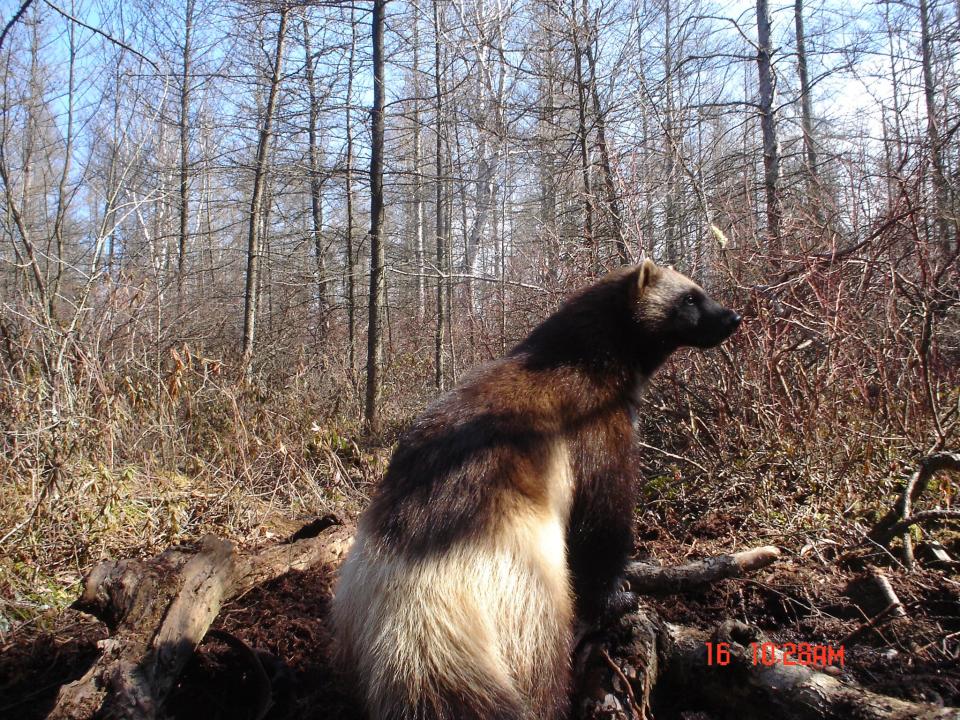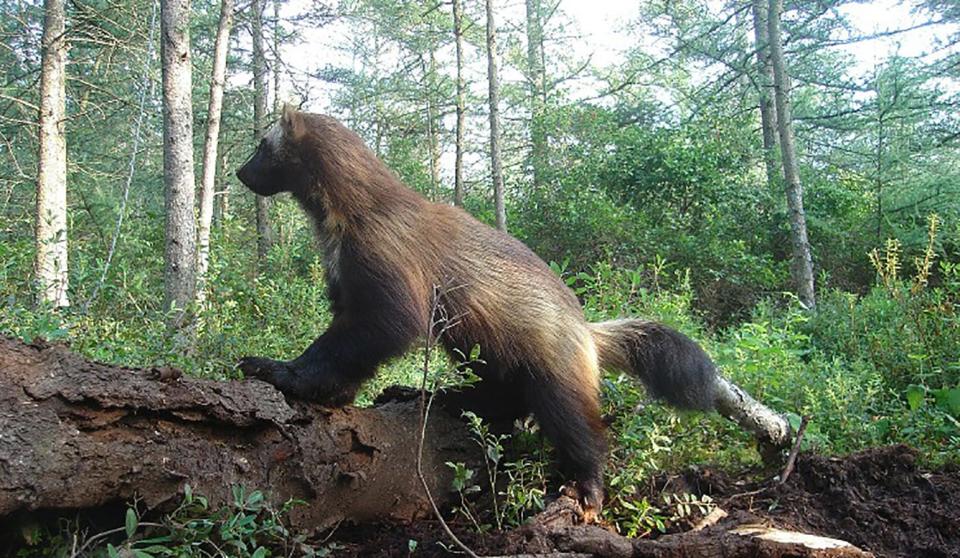Rubin: He went eye-to-eye with Michigan's only wolverine. Now he'd like to welcome more.
Jeff Ford stared down the only wolverine to stalk the forests of Michigan in recorded history and lived to tell the tale. Now he thinks we need more of them — actual wolverines, finally, in the Wolverine State.
We have two at the Detroit Zoo, imported to ideally create a few others. We have figurative wolverines in our past, though it's likely no real population ever roamed our peninsulas. We have a potential template for creating a tribe, from a Western state that might bring them back.
And, we have one wolverine stuffed and on display at the Saginaw Bay Visitor Center — the same wayward female who came charging at an unarmed science teacher from Caro, and helped make him a proponent of making space for her cousins.
It was April 2005, and Ford was on one knee in a bog in Sanilac County, most of the way up the Thumb. He and a buddy, Jason Rosser, were changing the memory cards on a couple of heat-and-motion-detecting cameras parked near a bait pile stocked with a 40-pound deer quarter.

There was a rustle in the distance, Ford said, and he wondered in a whisper to Rosser whether that might be a deer, and then it was coming too fast and too low through brush too thick to be anything but sharp claws and ill temper.
"At first I thought, 'I'm gonna get to see a wolverine, I'm gonna get to see a wolverine, I'm gonna get to see a wolverine,' " Ford said. But then a brown package of full-tilt fury came into view, maybe 15 yards away, and he only had time to think, "I'm gonna die, I'm gonna die, I'm gonna die."
He didn't. He has had some heart problems, just like the carnivore he came to call "Pretty Girl," but he's still around to pine for wolverines and keep an eye on Colorado.
Wildlife officials there seem likely to welcome wolverines either later, if the U.S. Fish and Wildlife Service declares them threatened and wraps them in red tape, or sooner if the state can act on its own.
There are logical reasons not to do the same in Michigan, among them climate and geography, and the Michigan Department of Natural Resources has not indicated any interest in the concept.

But Pretty Girl made do in and around the Minden City State Game Area for six years, Ford noted, and while we're officially the Great Lakes State, we also happily answer to that other nickname.
"We are the Wolverine State,” he said. “We have the Michigan Wolverines. It would be exciting, just like with the cougar, to know we have another apex predator living here.”
Wide-shouldered and wide-ranging
Ford, 58, lives far enough on the outskirts of Caro that he sees more wildlife than cars. He had a heart transplant in 2018, but that didn't stop him from tromping into the woods to scout bucks last week, getting ready for bow season.
He has been an admirer of apex predators since age 10, when his family surprised a grizzly bear on a trail at Glacier National Park in Montana. "He could have killed us all," Ford said, "but he ran up the mountain."
It was the power that impressed him more than the generosity, and he sees the same rippling strength on a smaller scale in wolverines — which are not members of the bear family, but rather weasels.
Solitary, territorial and grumpy by nature, they eat mostly carrion but will cheerfully attack smaller mammals or even deer and moose, particularly if the larger animals are handicapped by snowdrifts.
Males can weigh more than 40 pounds, females typically less. Powerfully built and known for wide, rounded heads, they top out around 18 inches at the shoulder and are even stronger than they look. Ford had to start strapping down the deer quarters on the bait pile because otherwise, Pretty Girl would carry them out of camera range.
They can cover 15 miles a day, and will go where the spirit and sustenance move them. The first wolverine seen in Colorado since 1919 showed up in 2009 after being tagged 500 miles earlier in Wyoming. Seven years later, it was shot to death by a ranch hand in North Dakota.

In the wild, they mostly like cold, snow and higher altitudes: Northern Canada, Alaska, Siberia. They're also found in Scandinavia, and have been spotted in the past few decades in the Sierra Nevadas, Washington's North Cascades, and suitably chilled spots in Idaho, Montana, Oregon and Utah.
At the Detroit Zoo, they’re between the bison and the bald eagle.
More from Neal Rubin: Oak Park woman gets $88,550 after lawn service's mistake
Hoping for heirs at the zoo
Yaroslawl, 7, and Janis, 6, flew to Detroit from Sweden in the spring of 2018. They are theoretically a breeding pair, though no kits have been produced so far.

Old instincts die hard, said mammal supervisor Rebecca Boonenberg; aloof in the wild, they tend to stake out opposite sides of their enclosure except during the summer mating season, when Janis allows her romantic partner to cross the unmarked border for three or four days of potential procreation.
“They’re favorites of ours,” Boonenberg acknowledged, with distinct personalities.
Janis is more outgoing and inquisitive. Yaroslawl is timid, at least by wolverine standards, pausing a moment to figure things out when a new food or potential plaything is placed in front of him.
Parentally speaking, wolverines are delayed implanters, meaning zookeepers won’t know whether Yaroslawl’s recent overtures were successful until as late as April.

From a climatic standpoint, Boonenberg said, the deep snow of the U.P. might suit wolverines.
From a game management standpoint, turning wolverines loose in Michigan is "beyond my realm."
From an animal lover’s standpoint, “they have those tiny, rounded ears … it’s the most adorable thing about them.”
Ferocity, or gluttony?
George Armstrong Custer was not thinking of cute ears when he hollered "Come on, you Wolverines!" to the Michigan brigades who helped smack down Robert E. Lee at Gettysburg.
It's unclear how that nickname came to be associated with Michigan and Michiganders, but in the heat of battle, it was a decidedly complimentary reference to ferocity.
One theory says the name was inspired by the gluttonous appetites of early French trappers, who supposedly gorged like wolverines.
A second suggests that it stems from the state's former abundance of wolverines, but it turns out the specimen Ford saw and photographed is the only one known to have visited Michigan since the Europeans showed up and started taking notes.

"Maybe in the Ice Ages, sure," said Cody Norton, the bear, fur-bearing and small game specialist for the Michigan Department of Natural Resources. But no fossilized wolverine skeletons have been found, and random bones have turned up only at human settlements, an indication that they were transported by fur trappers collecting pelts elsewhere.
It is known that in the 1830s Toledo War that gave Michigan the Upper Peninsula copper mines and left Ohio with Woody Hayes, the Michiganders were called wolverines. Unclear, however, is whether the name was self-assigned, or delivered as an insult.
The University of Michigan's Bentley Library delved into the subject and came away as flummoxed as everyone else, but did learn that legendary U-M football coach Fielding Yost was so impressed with the University of Wisconsin's live badger in 1923 that he set out to obtain a wolverine.
It took some effort, but come 1927, 10 wolverines were imported from Alaska and housed at the Detroit Zoo. For a few seasons, two were brought to Michigan Stadium for big games and carried around in cages, but Yost's enthusiasm for the concept faltered.
"It was obvious," he said, "that the Michigan mascots had designs on the Michigan men toting them, and those designs were by no means friendly."
More from Neal Rubin Southfield animal hospital gives pets taste of chocolate at end of lives
Mistaken identities
Norton, the DNR expert, said reports of wolverine sightings in Michigan are both frequent and universally mistaken.
Often, he said, word comes from a tourist who expects to see wolverines because he follows Big Ten sports.
"A lot of times, it's porcupines on trail cameras. Or fishers, a little smaller, also from the weasel family," he said. "Badgers, too, get confused with wolverines."

They all thrive in Michigan. Wolverines, he said, might not be so adaptable, in terms of sustaining a population.
They prefer mountainous terrain and snow deep enough for the females to carve dens. The snow requirement seems doable, but the highest point in Michigan is Mount Arvon in Baraga County at only 1,979 feet.
It's one thing to reintroduce a species, Norton said, but quite another to import an animal that has never called a region home.
A fierce affection, if not name
No one knows how Pretty Girl arrived in Michigan. It has been suggested that she sneaked an unwitting ride on a Canadian garbage truck.
A few things Ford knows for certain are that she was first spotted in 2004, she was found dead in a creek by two hikers in March 2010, and that an autopsy said she had a heart problem.
Also, he said, nobody but him liked what he called her.
"People were kind of upset about 'Pretty Girl.' They wanted me to name her something fierce," he said.
Consider, though, that it took him 371 days from the time he first spotted her tracks to snap his first remote picture. Devote that kind of time and mileage to just finding something, then four more years photographing and protecting it, and there's a bond.
He used to fudge details about her location to keep trappers away. When she died, he mourned. He even co-authored a book about his experience, "The Lone Wolverine: Tracking Michigan's Most Elusive Animal," with writer Elizabeth Philips Shaw.

“This wolverine survived in a 14-acre bog for six years. She proved that you don’t have to have mountains,” Ford said, so how about huge swaths of the U.P. or a massive northern Michigan forest?
The problem is that you'd need a purpose to invite them in, and the state doesn't have one. That makes his Michigan wolverine the last one anyone is likely to see on film — and only two people saw it eye-to-eye, racing from the underbrush, probably thinking to scare off a red-tailed hawk and then veering dead right at the instinctively unwelcome sight of humans.
“We’ve got to get out of here right now,” Ford said, and for the first hot-walking quarter-mile on a 1.6-mile trek, he and Rosser couldn’t stop looking back.
Then they made it to their truck, and they looked at one another and exhaled and agreed that nothing better had ever happened in their lives.
Reach Neal Rubin at NARubin@freepress.com, or on X Marks the Twitter at @nealrubin_fp.
To subscribe to the Free Press at discount rates, click here.
This article originally appeared on Detroit Free Press: Michigan had 1 wolverine that didn't live at Detroit Zoo. He saw it.

